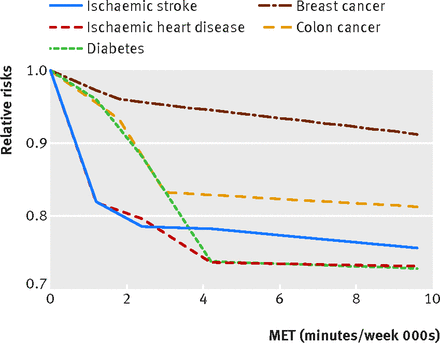Study: level of physical activity should be five to seven times higher than what WHO recommends.
Daily physical activity is effective in preventing diseases such as diabetes mellitus, ischemic stroke, ischemic heart disease, and reduces the risk of breast and colon cancer.

It has been proven that physical activity avoids a number of chronic and oncological diseases. However, according to a study by the University of Washington and the Institute for Health Assessment, WHO recommendations are not true and the level of activity must be five to seven times higher for a real result.
WHO now recommends a weekly physical activity of 600 MET (equivalent metabolic minutes, expressed in a ratio of ml / kg * min and reflects oxygen consumption per kilogram of mass per minute). This figure is 150 minutes of fast walking or 75 minutes of jogging.
According to the results of the study , people who are engaged in physical activity according to the WHO recommendations and, on average, pay 600 MET per week for this, have a 2% lower risk of diabetes compared with people who do not show activity. At the same time, with an increase in physical activity up to 3600 MET, the risk of diabetes mellitus falls much more significantly - already by 19% .
')

Schedule of reducing the risk of disease, depending on the number of MET per week
At the same time, a more serious increase in activity up to 9000 and 12000 MET gave a positive increase of only 0.6%, that is, respectively, almost did not positively affect the subjects.
Scientists divided the results into four groups for low-level (activity <600 MET, control group), low-activity (activity 600-3999 MET), intermediate-level (activity 4000-7999 MET) and highly active (activity ≥8000 MET) of subjects.
| Degree of risk reduction depending on the activity groups (%) | crayfish mammary gland | crayfish colon | diabetes | ischemic disease hearts | ischemic stroke |
|---|---|---|---|---|---|
| <600 MET | 0 | 0 | 0 | 0 | 0 |
| 600-3999 MET | 3 | ten | 14 | sixteen | sixteen |
| 4000-7999 MET | 6 | 17 | 25 | 23 | nineteen |
| ≥8000 MET | 14 | 21 | 28 | 25 | 26 |
Researchers note that MET is an equivalent quantity, and not an expression of activity only when running or walking. So, scientists recommend to distribute the load evenly, for example, to devote half an hour to work in the garden, some time for jogging, walking or other activity.
The work of BJM researchers was observational in nature and, of course, their conclusions cannot be considered as an unequivocal truth, but their work provides some “food” for thought. There are also a number of "weaknesses" of this work. In the course of the study, scientists relied on the results not only of their statistics, but also of other studies conducted earlier. At the same time, they were limited to only two databases of work with the results that were published in English, so some of the results that could be obtained by their foreign colleagues, but were not published within the framework of these two bases, remained unavailable to them.
The obtained data clearly show that the recommended level of activity of 600 MET / week by WHO is seriously underestimated, since the real effect on health in terms of prevention of a number of chronic diseases occurs only when the activity increases several times. At the same time, the upper threshold of physical exertion, at which the positive effect disappears, was not revealed by scientists.
Source: https://habr.com/ru/post/396655/
All Articles